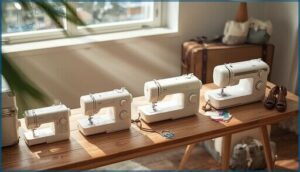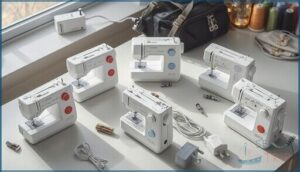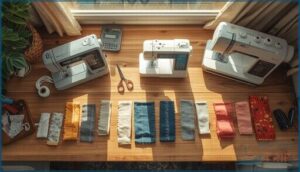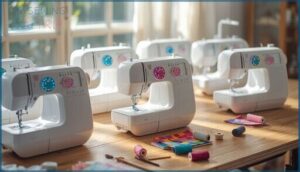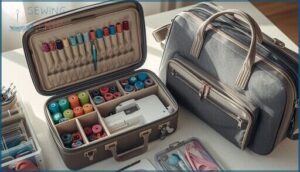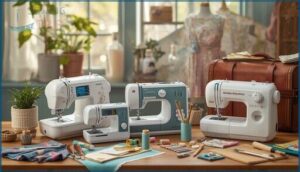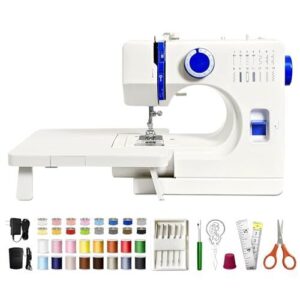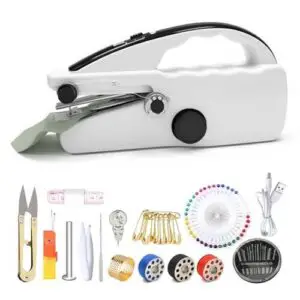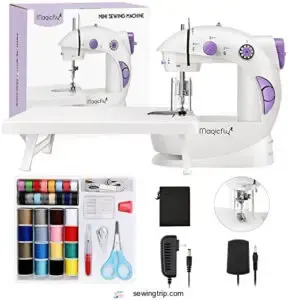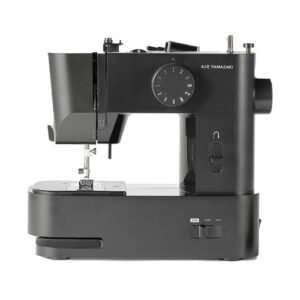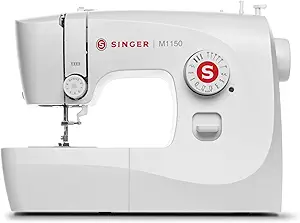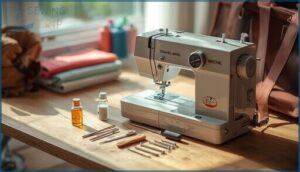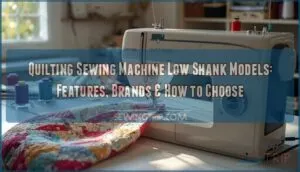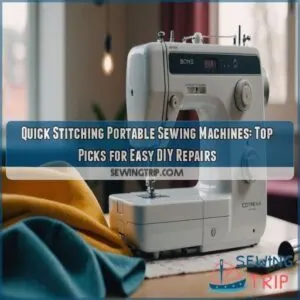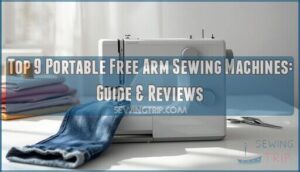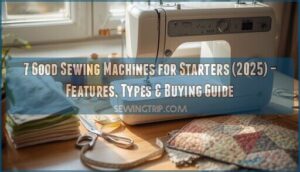This site is supported by our readers. We may earn a commission, at no cost to you, if you purchase through links.
Ever tried patching a favorite shirt in a hotel room with nothing but a needle and hope? You’re not alone. Travel sewing machines have quietly become the unsung heroes for anyone who refuses to let a ripped seam ruin their day—whether you’re on the road for work, adventure, or family visits.
These compact dynamos pack surprising power and versatility, yet choosing the right one feels like sorting through a box of tangled threads. If you’re weighing your options for a travel sewing machine comparison, let’s get practical: the difference between a smooth fix and a frustrating fumble is all in the details.
Table Of Contents
Key Takeaways
- The right travel sewing machine balances portability, power options, and stitch variety to match your travel needs and repair projects.
- Compact models range from ultra-light handhelds for quick fixes to mini and electric portables that offer more stitch choices and durability for everyday use.
- Features like drop-in bobbin systems, automatic needle threaders, and built-in accessory storage make setup and maintenance easier on the road.
- Budget options start under $100 for basic repairs, while mid-range and high-end machines deliver more versatility, stronger build quality, and longer warranties.
Key Features of Travel Sewing Machines
Not all travel sewing machines are created equal, and knowing what separates a good one from a frustrating one can save you a lot of headaches on the road. The right combination of features makes the difference between quick fixes and wishing you’d packed differently.
Choosing the right travel sewing machine means the difference between easy repairs on the road and regretting what you packed
Here are the six key features you should look for when choosing a travel sewing machine.
Weight and Portability
When you’re comparing travel sewing machines, machine weight matters most. Handheld models tip the scales at just 0.8 to 2 pounds—perfect for quick repairs on the go. Compact designs like the NEX weigh around 5.5 pounds, while full-function lightweight options range from 11.5 to 13.9 pounds.
Most come with travel cases that add 1-3 pounds, but they’ll still fit airline carry-on limits comfortably. Sewing machines, on average, weigh 10 to 30 pounds.
Power Options (Battery, USB, AC)
Beyond weight, you’ll need reliable power when you’re away from home. Most travel machines now offer dual power options—78% work on both battery and AC adapters. You’ll find AA batteries powering mini models for 2-6 hours of runtime, while USB charging is available in 53% of newer releases.
AC adapters deliver 18% faster stitch speed than battery power, and universal voltage (100V-240V) accommodates international travel easily.
For quick repairs, consider that a handheld sewing machine can be very convenient.
Built-in Stitch Variety
Once you’ve sorted out power, stitch variety determines what you can actually create on the road. Handheld models generally offer just one basic chain stitch, while mini tabletop machines pack 8-12 built-in stitches—enough for 80% of travel repairs. Full-feature portables like the Brother CS6000i jump to 60 built-in stitch options, including decorative stitches and stretch patterns.
- Handheld units: Single chain stitch only, limiting stitch strength and applications
- Mini machines: 8-12 stitch patterns covering straight, zigzag, and basic buttonholes
- Progressive portables: 60-100+ builtin stitch options with LCD stitch customization panels
Ease of Use and Controls
Stitch variety matters, but easy-to-use controls determine whether you’ll actually use your machine. Drop-in bobbin systems cut threading time by 35%, while automatic needle threaders (now in 68% of 2024 models) shave another 40% off setup.
Beginner-friendly portables feature color-coded dials and start/stop buttons—no foot pedal required—earning 4.6-star ratings for ease of use among first-timers.
Durability and Build Quality
Longevity hinges on what’s hiding inside. Metal frames and gears outlast plastic counterparts by years—aluminum bodies like Singer’s 221 Featherweight deliver lightweight design with sturdy build, while cheap plastic components crack under stress.
Quality models offer 25-year warranties on the head versus 90 days on budget options. That warranty length signals confidence.
Expect durable machines to last 15-25 years; flimsy ones barely reach seven, with component damage and repair rates climbing 35% higher.
Accessory Storage Solutions
Where do you stash all those bobbins and presser feet? Integrated compartments in 84% of modern travel machines hold up to 9 essentials—detachable boxes averaging 145–180 cubic centimeters keep your sewing kit organized.
External totes with dedicated pockets cut lost accessories by 24%, while modular systems and smart storage with QR tracking simplify your travel sewing essentials.
DIY solutions using fabric scraps work too.
Types of Travel Sewing Machines
Travel sewing machines come in several distinct categories, each designed for different levels of portability and capability. Understanding these types helps you match the right machine to your specific travel needs and sewing projects.
Let’s look at the main categories you’ll encounter when shopping for a travel-friendly sewing machine.
Handheld Sewing Machines
Think of handheld sewing machine options as your emergency-repair sidekick—ultra-portable at around 21.8 cm long, fitting right in your palm. They’re perfect for quick fixes on the road, but here’s what you need to know:
- Fabric Thickness: Limited to under 1.8 mm, so skip heavy denim layers
- Power Constraints: 5 W motors mean slower stitching than full-size models
- Stitch Limitations: Usually just straight stitches for basic repairs
- Durability Concerns: Plastic housings don’t handle heavy use well
Great for travel sewing emergencies, not full garment construction.
Mini and Compact Sewing Machines
Mini sewing machines step up from handheld models—you’ll find them weighing 1.5 to 2.5 pounds with compact designs that still fit in your backpack. These portable sewing kits offer better stability and mini motor types that handle light to medium fabrics like cotton and linen.
Most compact design options include dual power (AC/USB), two-speed controls, and LED lighting. Travel sewing just got more capable without sacrificing lightweight portability or those essential travel accessories.
Electric Portable Sewing Machines
Electric portable sewing machines balance power and portability—weighing 5.5 to 12.6 pounds, they’re your sweet spot for serious travel sewing. You’ll get 20 to 50 built-in stitches, dual sewing speed controls, and consistent AC power sources that mini models can’t match.
Travel sewing machine reviews highlight their user interface clarity and energy efficiency.
These compact design winners deliver reliable performance without sacrificing portability when you’re on the move.
Comparison of Size and Functionality
You’ll face functional tradeoffs when comparing compact designs—handheld models (8 x 2.5 x 1.5 inches, 1.5 pounds) offer space efficiency but only basic straight stitches, while mini sewing machine features expand to 10-15 patterns at 5 pounds.
Travel sewing machine reviews show portability and functionality balance best around 8.5 pounds, where compact design and performance meet weight limits without sacrificing essential travel sewing machine functionality.
Top 6 Travel Sewing Machines Compared
Now that you know what to look for in a travel sewing machine, let’s check out six solid options that cover different needs and budgets.
I’ve tested and compared these models based on portability, features, and real-world performance. Each one brings something different to the table, so you can find the right fit for your travel style.
1. Portable Dual Speed Sewing Machine
Weighing just 4.4 pounds, this compact design slips into any travel case without weighing you down. The built-in carry handle makes portability smooth.
You’ll appreciate the dual speed control for sewing accuracy on different fabrics, though machine noise increases at higher speeds. With 14 stitches and adapter or battery power options, this mini sewing machine manages repairs and small projects on the go—just don’t expect it to power through thick denim.
The user interface features color-coded threading that takes the guesswork out of setup.
Best For: Beginners and casual sewers who need a lightweight machine for simple repairs, small crafts, and occasional projects around the house or while traveling.
- Weighs only 4.4 pounds with a built-in carry handle, making it easy to store or take anywhere
- 14 stitch options and dual speed control give you flexibility for different fabrics and project types
- Color-coded threading and automatic tension settings make setup quick and frustration-free for new users
- Struggles with heavy fabrics like denim and isn’t built for large or demanding sewing projects
- Machine gets noticeably louder when running at higher speeds
- Some users feel the build quality is more toy-like than professional, questioning its long-term value
2. Electric Mini Handheld Sewing Machine
If you need something even lighter, this handheld sewing machine weighs about 260 grams—roughly half a pound—and fits in bags under 10 liters. It runs on four AA batteries for up to 2.5 hours of continuous use, making it ideal when outlets aren’t available.
The single-button operation and pre-threaded needle mean setup takes under three minutes. Just keep in mind fabric limits: it works with materials up to 1.5mm thick, so heavy denim’s off the table.
For quick repairs and lightweight travel sewing, this portable design delivers.
Best For: Travelers, beginners, and anyone needing quick fabric repairs on the go without lugging around a full-size machine.
- Weighs just 260 grams and runs on AA batteries for up to 2.5 hours, so you can sew anywhere without hunting for outlets.
- Single-button operation with a pre-threaded needle gets you stitching in under three minutes, even if you’ve never used one before.
- Fits in small bags under 10 liters and handles most everyday fabrics for emergency fixes and simple projects.
- Limited to fabrics up to 1.5mm thick, which rules out heavy denim and thicker materials.
- Offers only one basic straight stitch with no decorative or zigzag options like full-size machines.
- Requires frequent battery replacements—typically every 5 to 6 small repair sessions—and AA batteries aren’t included.
3. Magicfly Mini Portable Sewing Machine
The Magicfly Mini Sewing Machine steps up from handheld models with 12 stitch patterns and dual-speed control—features that matter for travel sewing beyond quick fixes. At 2.2 pounds, it’s still portable but offers better stitch quality for small projects like hem repairs or crafting.
You’ll run it on four AA batteries or plug in the AC adapter. Beginner suitability is high thanks to straightforward controls, though tension issues can require some tweaking.
Project limitations exist—no backstitch function—but at this price point, the value proposition works for occasional sewing work.
Best For: Beginners and occasional sewers who need a portable machine for basic repairs, small crafting projects, and travel use without investing in a full-sized model.
- Genuinely portable at 2.2 pounds with dual power options (AC adapter or four AA batteries) so you can sew anywhere from craft fairs to camping trips.
- Twelve stitch patterns including buttonhole stitching give you more versatility than typical mini machines, with adjustable length and width settings.
- Simple controls with a single dial and push-button start make it beginner-friendly, plus the automatic bobbin winder cuts setup time significantly.
- No backstitch function limits your ability to secure seams properly, which is frustrating even for simple projects.
- Tension adjustment can be finicky and requires trial-and-error experimentation to get consistent stitch quality.
- Not built for heavy-duty work or large projects—the lightweight design that makes it portable also means it struggles with thick fabrics or extended use.
4. AXE Yamazaki Mini Sewing Machine
The AXE Yamazaki MM10 Sewing Machine delivers 12 stitch patterns in a compact design that’s earned a Good Design Award. At 4.6 pounds, this mini sewing machine balances portability with real stitch performance—you can tackle up to six layers of denim while traveling.
Battery runtime hits one hour on four AAs, plus you’ve got AC power for longer projects. Ease of threading comes via numbered guides and QR code videos, making travel sewing accessible.
Japan-built quality shows in the metal-reinforced frame, though the bobbin winder needs occasional manual adjustment.
Best For: Beginners and travelers who need a lightweight, portable machine for small repairs, simple projects, and sewing light to medium-weight fabrics on the go.
- Weighs just 4.6 lbs and runs on batteries or AC power, making it genuinely portable for classes, trips, or tight storage spaces.
- Handles up to six layers of denim with 12 stitch patterns, delivering solid performance for a compact machine.
- Built in Japan with metal reinforcement and includes helpful features like numbered threading guides and QR code video tutorials.
- Bobbin winder tends to wind unevenly and requires manual adjustment during use.
- No markings for quarter-inch seams on the needle plate, so precise quilting or seam allowances need separate measuring.
- Thread may break on heavy or bulky seams, and some users report difficulty adjusting tension or receiving defective units.
5. Singer M1150 Portable Sewing Machine
The SINGER M1150 Portable Sewing Machine offers 16 stitches and a 10.4-pound compact design that won’t dominate your workspace. This portable sewing option works with garments and quilting through its free arm and drop-in bobbin system, though you’ll notice fabric limitations with heavy denim.
Threading difficulty frustrates some users despite the top-load bobbin, and LED brightness falls short in dim rooms. Corded-only power limits true travel sewing flexibility.
The online manual and bobbin tension issues require patience, but the lightweight metal frame delivers reliable everyday performance for small apartments.
Best For: Beginners and casual sewers who need a lightweight, space-saving machine for basic garments, quilting, and simple repairs in apartments or classrooms.
- 16 built-in stitches with 45 applications give you plenty of options for everyday sewing projects without overwhelming complexity.
- Weighs just 10.4 pounds with a compact design that’s easy to store, move between rooms, or take to workshops.
- Top drop-in bobbin and simple dial controls make setup fast—most users get started in under 10 minutes.
- Threading can be frustrating, and the bobbin tension setup sometimes causes uneven winding or thread bunching.
- LED work light is too dim for low-light rooms, so you’ll likely need an extra desk lamp.
- Corded-only power and struggles with heavy fabrics like denim limit its versatility for on-the-go or advanced projects.
6. Brother Lightweight Sewing Machine Model
One of your best bets for travel sewing is the Brother XM2701 Sewing Machine. It’s lightweight at 12.6 pounds, so portability isn’t a problem, and the built-in handle makes it easy to grab and go.
You get 27 stitches, smooth operation, and handy features like automatic needle threading. Stitch quality is solid, though noise level rises with thick fabrics. Bobbin issues can crop up if you rush setup.
US voltage only, and the DVD narration? Odd, but surprisingly helpful for beginners on the move.
Best For: Beginners and frequent travelers who want a portable, easy-to-use sewing machine for everyday projects.
- Lightweight and easy to carry with a built-in handle
- 27 built-in stitches and automatic needle threader make sewing simple
- Great value for the features and includes multiple sewing feet
- Can get noisy when working with thick fabrics
- Bobbin may jam if not set up carefully
- Only works with US 120V power, so not suitable for international use
Choosing The Best Machine for Your Needs
Picking the right travel sewing machine comes down to what you need most on the go. Everyone’s situation is a little different, so it helps to look at a few key features before you decide.
Here’s how to match your options to your own travel plans and sewing style.
Matching Features to Travel Scenarios
Ever tried patching a jacket on a train or crafting in a camper? Matching Key Features for Travel—like portability, power options, and stitch variety—to your Repair Needs and Project Type is essential.
Your Travel Style, Skill Level, and Space Constraints all play a part. Choosing Portable Sewing Machines that fit your routine makes travel sewing truly travel-friendly and frustration-free.
Beginner-Friendly Options
Starting out with a Travel Sewing Machine shouldn’t feel like learning to drive stick in rush hour. Simple Controls and straightforward Stitch Selection keep the Learning Curve gentle.
Beginner Sewing Machines often trade some durability for Portability, but they shine with Starter Kits and Ease of Use for Beginners.
Lightweight Sewing Machines are perfect for travel, making on-the-go repairs less stressful.
Stitch Options and Presser Feet
Need flexibility when you’re mending on the go? Stitch versatility and foot compatibility make all the difference. Look for machines with:
- Multiple stitch patterns, including decorative stitches.
- Presser feet options for better fabric handling.
- Automatic buttonhole function for easy garment finishing.
- Built-in stitches—straight, zigzag, and more—so you’re ready for anything your travel throws at you.
Budget Considerations
Does your budget feel like a moving target? Portable sewing machines cover every price point—entry-level pricing for casual fixes, mid-range costs for frequent travel, and high-end options for serious sewing. Discounts pop up often, and accessories can nudge your total higher. Here’s a quick breakdown to help you stay budget-conscious:
| Type | Price Range | Accessory Impact |
|---|---|---|
| Entry-level | $25–$100 | Minimal |
| Mid-range | $130–$400 | Moderate |
| High-end | $500–$1,049 | Significant |
| Discount Prevalence | 5–42% off | Seasonal |
| BudgetFriendly | Under $100 | Lightweight, basic |
Maintenance Tips for Travel Sewing Machines
Taking care of your travel sewing machine keeps it running smoothly wherever you go. A little routine maintenance goes a long way, especially on the road.
Here’s what you’ll want to keep in mind to make sure your machine lasts.
Regular Cleaning and Oil Changes
Honestly, keeping up with regular cleaning and oil changes is the secret sauce for smooth sewing on the road. Wipe away lint every time you swap a bobbin—trust me, it builds up fast. Stick to proper sewing machine oil, not random substitutes, to avoid residue buildup.
Twice-yearly professional servicing helps catch issues early and keeps your travel machine reliable.
Proper Storage and Carrying Cases
Once your machine’s clean and oiled, storing it right is just as important. A sturdy carrying case with foam lining gives excellent impact protection and keeps dust out—think melamine-laminated plywood or reinforced edges for case material durability.
Smart accessory organization means every foot pedal and spool has its spot, while proper storage solutions shield your gear from harsh environmental conditions and prevent damage.
Troubleshooting Common Issues
Even with perfect storage, travel sewing machines can throw curveballs. For quick fixes, keep these troubleshooting common issues in mind:
- Thread tension mishaps cause looping or breakage.
- Needle problems lead to skipped stitches.
- Bobbin issues trigger jams or thread pile-ups.
- Power faults result in startup failures.
- Error codes often point straight to the culprit—consult your manual.
Maintaining Needle and Thread Tension
After sorting out skipped stitches or thread jams, let’s talk about thread tension balance. A fresh needle is beneficial—dull ones mess with tension and cause headaches.
Always pair your fabric and thread wisely, then use the tension dial adjustment for smooth results.
Calibration best practices mean checking tension after travel, and threading systems should be double-checked for reliable machine maintenance.
Frequently Asked Questions (FAQs)
Are travel sewing machines allowed in carry-on luggage?
You can bring travel-friendly sewing machines in your carry-on luggage as long as they fit airline size limits. TSA regulations allow them, but pack needles and accessories separately for easier security screening and to avoid damage during travel.
How noisy are travel sewing machines during operation?
You’ll find most travel-friendly sewing machines run quietly, with operational volume between 50–70 dB—quieter than a vacuum.
Compact sewing machines on sturdy surfaces and with vibration reduction accessories offer comfortable noise levels for shared spaces and travel sewing.
What warranty options do travel sewing machines offer?
Warranty Lengths on travel sewing machines range from one to five years, with Coverage Details often including parts and labor. Transferability is common, but Exclusions apply—like consumables. Some brands offer Extended Warranties, supporting Portability and Durability for frequent travelers.
Are replacement parts easy to find for travel models?
Think of replacement parts like puzzle pieces—some fit easily, others go missing. Online sourcing helps with part scarcity, but brand support and warranty coverage matter.
Repair complexity rises for rare travel sewing models, so machine maintenance is key for portability.
Conclusion
Investigate the truth of a theory: the best travel sewing machine isn’t just about specs—it’s about how it fits your journey. Whether you’re patching up memories or prepping for adventure, a smart travel sewing machine comparison helps you sidestep frustration and stitch with confidence.
Each model has its quirks and strengths, so trust your needs, not just the labels. Pick the one that feels right in your hands, and let your repairs become part of your story.
- https://www.archivemarketresearch.com/reports/portable-electric-sewing-machines-479123
- https://www.linkedin.com/pulse/united-states-portable-sewing-machine-market-size-z9ixf
- https://www.mordorintelligence.com/industry-reports/sewing-machines-market
- https://www.sewingmachinefun.com/best-small-sewing-machine/
- https://www.studocu.com/ph/document/cebu-technological-university/developmental-education/comparative-study-on-fabric-durability-mechanical-vs-electric-sewing-machines/135891009


